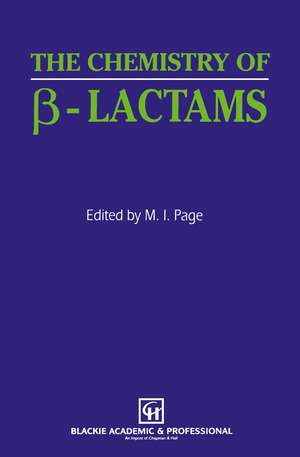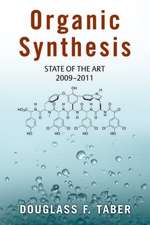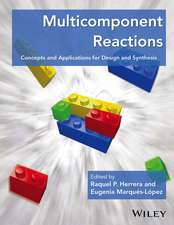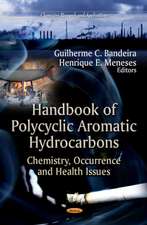The Chemistry of β-Lactams
Editat de M.I. Pageen Limba Engleză Paperback – 29 oct 2012
Preț: 392.75 lei
Nou
Puncte Express: 589
Preț estimativ în valută:
75.15€ • 78.75$ • 62.13£
75.15€ • 78.75$ • 62.13£
Carte tipărită la comandă
Livrare economică 12-26 aprilie
Preluare comenzi: 021 569.72.76
Specificații
ISBN-13: 9789401053006
ISBN-10: 9401053006
Pagini: 376
Ilustrații: XIX, 351 p.
Dimensiuni: 155 x 235 x 25 mm
Greutate: 0.53 kg
Ediția:Softcover reprint of the original 1st ed. 1992
Editura: SPRINGER NETHERLANDS
Colecția Springer
Locul publicării:Dordrecht, Netherlands
ISBN-10: 9401053006
Pagini: 376
Ilustrații: XIX, 351 p.
Dimensiuni: 155 x 235 x 25 mm
Greutate: 0.53 kg
Ediția:Softcover reprint of the original 1st ed. 1992
Editura: SPRINGER NETHERLANDS
Colecția Springer
Locul publicării:Dordrecht, Netherlands
Public țintă
ResearchCuprins
1 The biosynthesis of ?-lactams.- 1.1 Introduction.- 1. 2 Penicillin and cephalosporin biosynthesis.- 1.3 Clavulanic acid biosynthesis.- 1.4 Carbapenem biosynthesis.- 1.5 Monocyclic ?-lactam biosynthesis.- References.- 2 Structure-activity relationships: chemical.- 2.1 The reactivity of the ?-lactam.- 2.2 Structural and ground-state effects.- 2.3 Kinetie effects.- 2.4 Summary of kinetic and ground-state effects.- 2.5 Structure-chemical reactivity relationships.- 2.6 Ease of C-N bond fission in ?-lactams.- References.- 3 Structure-activity relationships: biological.- 3.1 Introduction.- 3.2 General aspects.- 3.3 Natural penicillins.- 3.4 Penicillinase-resistant antistaphylococcal penicillins.- 3.5 Amino penicillins.- 3.6 Carboxy and sulfo penicillins.- 3.7 Acyl-ureido penicillins.- 3.8 Amidino penicillanic acid penicillins.- 3.9 6-?-Substituted penicillins.- 3.10 Cephalosporins.- 3.11 7-?-Acylamino group modifications.- 3.12 Substitutions on the 7-?-position.- 3.13 C-3 Substituent modifications.- 3.14 Orally adsorbed cephalosporins.- 3.15 Oxacephalosporins.- 3.16 Carbapenems.- 3.17 Penems.- 3.18 Monobactams.- 3.19 ?-Lactamase inhibitors.- 3.20 Conclusions.- References.- 4 The mechanisms of reactions of ?-lactams.- 4.1 Introduction.- 4.2 The aminolysis of ?-lactam antibiotics.- 4.3 Metal-ion catalysed hydrolysis.- 4.4 Micelle catalysed hydrolysis.- 4.5 The direction of nucleophilic attack.- 4.6 Thiazolidine ring opening.- References.- 5 Mode of action: interaction with the penicillin binding proteins.- 5.1 Introduction.- 5.2 Structure and biosynthesis of peptidoglycan.- 5.3 Penicillin-recognizing proteins as members of an ‘active serine’ enzyme family.- 5.4 Kinetics of the ?-lactam-PRP interaction.- 5.5 The physiological function of PBPs.- 5.6 PBPs involvedin resistance to ?-lactams.- 5.7 Site-directed mutagenesis results.- 5.8 Conclusions and perspectives.- Acknowledgements.- Dedication.- References.- 6 ?-Lactamase: mechanism of action.- 6.1 Introduction.- 6.2 Acyl-enzyme mechanism of ?-lactamase action: dass A ?-lactamases.- 6.3 The acyl-enzyme mechanism of ?-lactamase action: class C ?-lactamases.- 6.4 Metalloenzyme mechanism of ?-lactamase action.- Acknowledgements.- References.- 7 ?-Lactamase: inhibition.- 7.1 Introduction.- 7.2 ?-Lactamase and DD-peptidase active sites: structure and mechanism.- 7.3 Inhibitors of the serine ?-lactamase.- 7.4 Inhibitors of class B (metallo) ?-lactamases.- 7.5 Clinical indications.- 7.6 Retrospects and prospects.- References.- 8 Novel ?-lactam structures - the carbacephems.- 8.1 Introduction.- 8.2 Nomenclature.- 8.3 Synthesis.- 8.4 Stability of the carbacephs.- 8.5 Structure-activity relationships in the carbacephems.- Acknowledgements.- References.- 9 Non-?-lactam mimics of ?-lactam antibiotics.- 9.1 Introduction.- 9.2 Pyrazolidinones.- 9.3 Lactivicin.- 9.4 ?-Lactams.- 9.5 Imidazolidinones.- 9.6 Oxaziridines and epoxides.- 9.7 Cydobutanones.- 9.8 ?-Lactones.- 9.9 Summary.- References.- 10 Classical ?-lactam structures.- 10.1 Introduction.- 10.2 Sheehan’s synthesis of penicillin V.- 10.3 Woodward’s synthesis of cephalosporin C.- 10.4 Biomimetic synthesis.- 10.5 Merck synthesis of ( ± )-cephalothin.- 10.6 The Hoechst synthesis.- 10.7 Woodward’s penem synthesis.- 10.8 The conversion of penicillins into cephalosporins.- 10.9 Cephamycin antibiotics.- 10.10 Merck synthesis of ( ± )-cefoxitin.- 10.11 Shionogi synthesis of a 7-?-methoxy-1-oxacephem.- 10.12 1 ,1-Dioxo-trans-7-methoxycephalosporanic acid t-butyl ester.- References.- Further reading.









